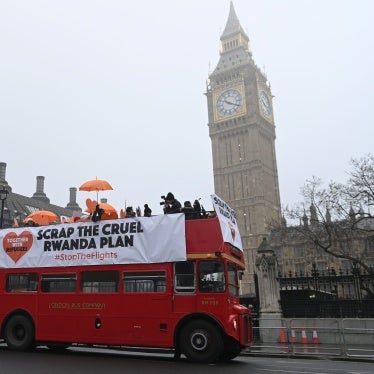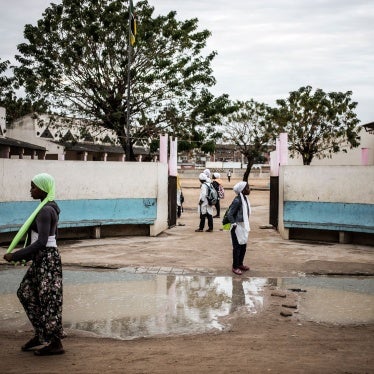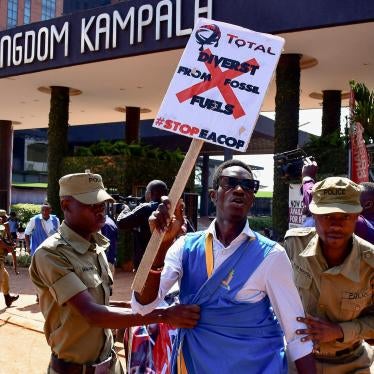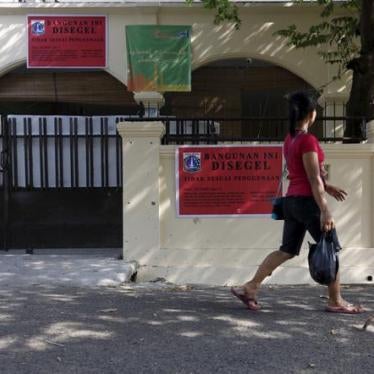(Nairobi) – Kenyan authorities should not return refugees to Somalia because of ongoing fighting and abuses against civilians in areas controlled by Kenyan forces and allied militias, Human Rights Watch said today. Instead of claiming that “newly liberated areas” are safe for refugee return, Kenyan authorities should reopen the screening center at Liboi and resume registration of new refugees to ensure they receive assistance, Human Rights Watch said.
“Fierce clashes in southern Somalia still pose a grave threat to civilians,” said Daniel Bekele, Africa director at Human Rights Watch. “Instead of peddling false claims that the border areas are safe, Kenya should focus on assisting and protecting refugees.”
Over the past months, prominent Kenyan officials have called for Somali refugees to go back to Somalia, claiming it is safe for them to return. During the week of March 19, 2012, both Foreign Affairs Minister Moses Wetangula and Internal Security Minister George Saitoti said that the Kenyan military has established a zone inside Somalia that is safe for returning refugees, reiterating President Mwai Kibaki’s statement to the London conference on Somalia on February 23.
Minister Saitoti was quoted in the media stating that, “Following the combined forces of KDF [Kenya Defence Forces] and AMISOM [African Union Mission in Somalia] some towns have been liberated and it is safe for the refugees to return.”
However, fighting is ongoing in the border towns and regions Kenya claims to control, and the Islamist militant group al-Shabaab maintains a significant presence there, Human Rights Watch said.
While the authorities have contended that returns would be voluntary, Human Rights Watch spoke to numerous victims of police abuses in Dadaab in December 2011, at least three of whom said that the police told them to “go back to Somalia” while beating them. The forced return of refugees to a country where they face persecution, torture, or situations of generalized violence – like Somalia – would violate African regional and international law.
Human Rights Watch said that there is fighting involving al-Shabaab in a number of areas held by the Kenyan Defence Forces (KDF) and militias allied to Somalia’s Transitional Federal Government (TFG). Kenya’s militarily intervened in Somalia against al-Shabaab on October 16, 2011, and Kenyan authorities have repeatedly referred to the areas where they are deployed along the Kenya-Somali border as “newly liberated.”
Human Rights Watch research found, however, that there have been recurrent clashes between the Kenyan and allied Somali forces and al-Shabaab’s fighters in Lower Juba, at the heart of the Kenyan-controlled zone. Two residents of Bills Qooqaani, 90 kilometers from the Kenya-Somali border town of Dhobley, told Human Rights Watch that al-Shabaab fighters attacked the town on March 17. A refugee from the Somali village of Taabta, 60 kilometers from Dhobley, said she fled on March 15 as a result of ongoing nightly attacks by al-Shabaab on a nearby Kenyan base.
On March 20, al-Shabaab fighters briefly retook the Somali village of Diif, five kilometers from the Kenyan border. Just a week earlier, on March 13, three boys were beheaded on the road between Diif and Dhobley by al-Shabaab fighters, according to credible sources.
Fighting and displacement are also taking place in Gedo region, on the northern edge of the so-called liberated areas. On March 12, al-Shabaab fighters ambushed a joint Kenyan-TFG convoy outside the village of Taraak. Local contacts told Human Rights Watch that on March 8 a car filled with people fleeing from Mogadishu to Kenya hit a landmine between Belet Hawa and El Waq.
“People are fleeing the so-called liberated areas, not returning to them,” Bekele said.
The United Nations has reported the displacement of thousands of civilians from Lower Juba and Gedo regions recently – including from towns purportedly under Kenyan and TFG control, such as Bills Qooqaani – to Somalia’s capital, Mogadishu. A credible source told Human Rights Watch that Kenyan and TFG military forces have occupied schools in Gedo, making it impossible for classes to continue.
Local sources in Dhobley told Human Rights Watch that very few humanitarian agencies have staff in the border region, including in Dhobley itself, the main border crossing for refugees.
While the Kenyan authorities have valid concerns about the environmental and security impact of hosting hundreds of thousands of Somali refugees, these concerns in no way justify encouraging refugees to return to a war zone, Human Rights Watch said.
Human Rights Watch called on the Kenyan authorities to resume the registration of new arrivals in the Dadaab refugee camps on the Kenyan side of the border, which has been suspended since October. It also reiterated its call on Kenya to open a new refugee reception center in the Kenyan border town of Liboi to ensure that refugees are screened for security purposes and safely transported to the camps in Dadaab.
Kenya should improve security for the refugees and the local community in Dadaab by investigating and prosecuting officers responsible for recent abuses against refugees, including a police raid December in which over 100 refugees were beaten, Human Rights Watch said.
“Kenya’s concerns and legal obligations are better met by registering, screening, and protecting refugees, not by misrepresenting the security situation in Somalia,” Bekele said.






